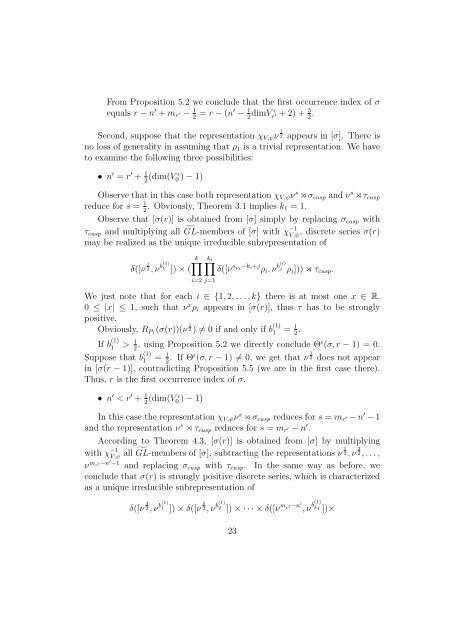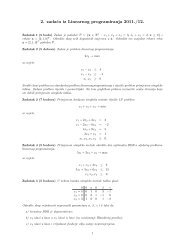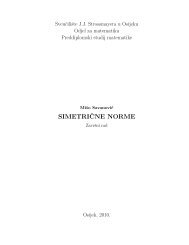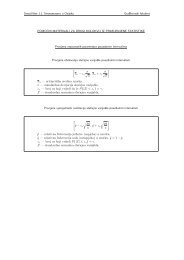Theta lifts of strongly positive discrete series: the case of (˜ Sp(n),O(V ))
Theta lifts of strongly positive discrete series: the case of (˜ Sp(n),O(V ))
Theta lifts of strongly positive discrete series: the case of (˜ Sp(n),O(V ))
Create successful ePaper yourself
Turn your PDF publications into a flip-book with our unique Google optimized e-Paper software.
From Proposition 5.2 we conclude that <strong>the</strong> first occurrence index <strong>of</strong> σequals r − n ′ + m r ′ − 1 2 = r − (n′ − 1 2 dimV ɛr ′ + 2) + 3 2 .Second, suppose that <strong>the</strong> representation χ V,ψ ν 1 2 appears in [σ]. There isno loss <strong>of</strong> generality in assuming that ρ 1 is a trivial representation. We haveto examine <strong>the</strong> following three possibilities:• n ′ = r ′ + 1 2 (dim(V ɛ0 ) − 1)Observe that in this <strong>case</strong> both representation χ V,ψ ν s ⋊σ cusp and ν s ⋊τ cuspreduce for s = 1. Obviously, Theorem 3.1 implies k 2 1 = 1.Observe that [σ(r)] is obtained from [σ] simply by replacing σ cusp withτ cusp and multiplying all <strong>˜</strong>GL-members <strong>of</strong> [σ] with χ−1V,ψ, <strong>discrete</strong> <strong>series</strong> σ(r)may be realized as <strong>the</strong> unique irreducible subrepresentation <strong>of</strong>k∏ ∏k iδ([ν 1 2 , νb (1)1 ]) × ( δ([ν aρ i −ki+j ρ i , ν b(i) jρ i ])) ⋊ τ cusp .i=2 j=1We just note that for each i ∈ {1, 2, . . . , k} <strong>the</strong>re is at most one x ∈ R,0 ≤ |x| ≤ 1, such that ν x ρ i appears in [σ(r)], thus τ has to be <strong>strongly</strong><strong>positive</strong>.Obviously, R P1 (σ(r))(ν 1 2 ) ≠ 0 if and only if b (1)1 = 1 2 .If b (1)1 > 1 2 , using Proposition 5.2 we directly conclude Θɛ (σ, r − 1) = 0.Suppose that b (1)1 = 1 2 . If Θɛ (σ, r − 1) ≠ 0, we get that ν 1 2 does not appearin [σ(r − 1)], contradicting Proposition 5.5 (we are in <strong>the</strong> first <strong>case</strong> <strong>the</strong>re).Thus, r is <strong>the</strong> first occurrence index <strong>of</strong> σ.• n ′ < r ′ + 1 2 (dim(V ɛ0 ) − 1)In this <strong>case</strong> <strong>the</strong> representation χ V,ψ ν s ⋊ σ cusp reduces for s = m r ′ − n ′ − 1and <strong>the</strong> representation ν s ⋊ τ cusp reduces for s = m r ′ − n ′ .According to Theorem 4.3, [σ(r)] is obtained from [σ] by multiplyingwith χ −1V,ψ all <strong>˜</strong>GL-members <strong>of</strong> [σ], subtracting <strong>the</strong> representations ν 1 2 , ν 3 2 , . . . ,ν m r ′−n′ −1 and replacing σ cusp with τ cusp . In <strong>the</strong> same way as before, weconclude that σ(r) is <strong>strongly</strong> <strong>positive</strong> <strong>discrete</strong> <strong>series</strong>, which is characterizedas a unique irreducible subrepresentation <strong>of</strong>δ([ν 3 2 , νb (1)1 ]) × δ([ν52 , νb (1)2 ]) × · · · × δ([νm r ′−n ′ , ν b(1) k 1 ])×23
















